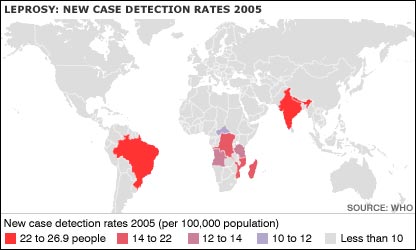Welcome
to Johnbirchall-economist.com!
(Leprosy remains
a problem – a brief analysis)
Leprosy, an age old disease closely
associated with biblical times, has not gone away. In fact, about 500,000
new cases - more than 1,400 people every day - were diagnosed in 2005.
In 1996 the World Health Organisation
said it hoped to all but eliminate the disease within 10 years.
But in 2006 people in South America,
Asia and Africa are still living with this debilitating illness even
though a cure, which is available for free, was found more than 20 years
ago.
It is hard to pinpoint why it is taking
so long to eradicate an illness that has not been found in Europe for
decades.
Tim Lewis, a doctor working in Nepal for
the Leprosy Mission International thinks the continued stigma surrounding
the disease could be to blame.
He said: "There is definitely still
a stigma surrounding leprosy. We are still seeing some patients coming at
quite an advanced stage of disease and the main reason why people delay
treatment is still fear of rejection."
"We had one case where a man with
the disease lived with his family, but they drew a line down the centre of
the house and told him to stay on his side. His food was then passed over
the line."
Total
number of new cases in 2005 (Source: WHO)
-
SOUTH
EAST ASIA - 201,635
-
AFRICA
- 42,814
-
AMERICAS
-52,662 (2004 figure)
-
WESTERN
PACIFIC - 7,137
-
EASTERN
MEDITERRANEAN - 3,133
June Nash, a missionary for more than 30
years, has also witnessed first hand the shame a leprosy diagnosis can
induce. She recalled the story of one patient from Africa who thought she
would have to get a divorce after being diagnosed.
She said: "The patient was cured of
the disease and didn't have any disabilities but was convinced she would
have to leave her husband just because of the shame."
Daniel
Izzett, a pastor in Zimbabwe, began losing the feeling in his fingers when
he was a child but was not treated for the illness until he was 24. He
told his immediate family but admits delaying telling anyone else because
he feared their reaction.
"I
was almost living in denial but it was 10 years before I was told I had
leprosy after being continually misdiagnosed.
"I
told my family and my bosses at work because I needed time off for
treatment but generally we kept it a great secret because of the stigma.
It seems an unwritten law in society - fear of leprosy."
Curable
disease
Most
of the worries surrounding leprosy may stem from the fact that it is
probably spread by airborne infection such as coughing and sneezing. The
first outward sign is a patch on the skin, usually associated with loss of
feeling around that area.
However,
it is now thought that 95% of people are naturally immune to the leprosy
bacteria and once a patient begins treatment they are no longer
infectious.
Multi drug
therapy also cures most victims but physical deformities, including
damaged hands and feet, remain. This may make it hard for family and
friends to accept sufferers.

Another
factor which could have added to leprosy's doomed reputation includes the
once prevalent 'solution' of transporting sufferers to leper colonies,
also known as Leprosaria, which were often located on remote islands.
Transferring
patients to these far-away places added to the mythology that the disease
was 'dangerous' according to Ms Nash.
"The
health profession certainly did not help early-on because removing these
people from society simply reinforced the misconceptions," she said.
Most
colonies were closed in the 1960s, when drug treatments began to advance,
but in Japan the last one remained open until 1996.
A
government panel which reported on Japan's health policy towards lepers in
2005 also found that for a period of 30 years, up to at least the 1950s,
the babies of hundreds of patients were deliberately killed by medical
staff.
Some
colonies are still operating in Eastern Europe and India mainly because
sufferers are now used to living cut-off from society and feel safer in
these controlled environments.
Tackling
long held worries about rejection and shame seems key to overcoming the
illness in the long term because the sooner people are treated the less
likely they are to become seriously disabled.
Pastor
Izzett thinks the attitude is changing.
He
said: "My family kept it secret for 28 years before going public but
when I told the church where I am the pastor no-one rejected us. In fact
most of the remarks were 'why didn't you tell us before?'."
The
WHO's desire to eliminate leprosy may eventually be achievable within a
few years but the fight is far from over.
Julie
Lewis, another missionary in Nepal, thinks tackling poverty on a global
level would be a start.
"If
you raised the living conditions of everybody in the world leprosy would
automatically disappear. It disappeared from Europe before a treatment was
available just because people's living conditions improved," she
said.
And in the meantime education and awareness needs
to continue if a world without leprosy, a disease as old as mankind, is
ever going to exist.